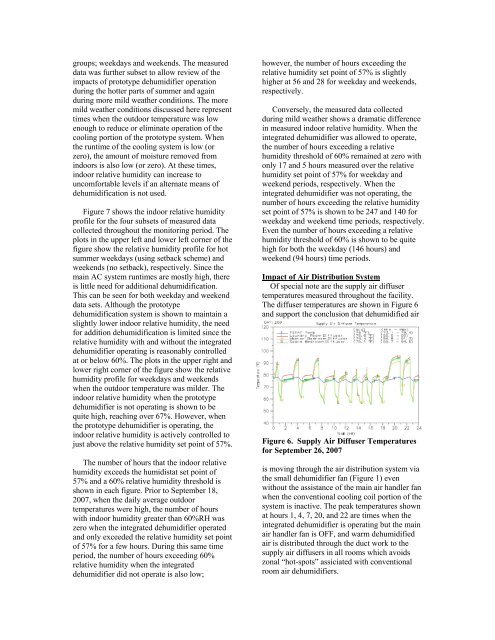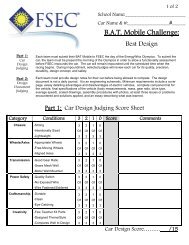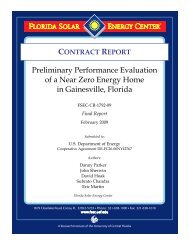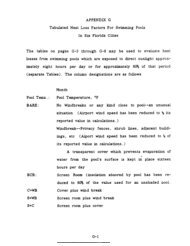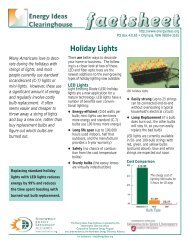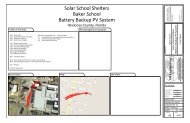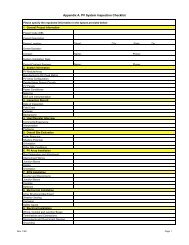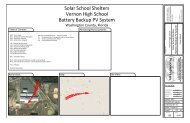Case Study of an Innovative HVAC System with Integral Dehumidifier
Case Study of an Innovative HVAC System with Integral Dehumidifier
Case Study of an Innovative HVAC System with Integral Dehumidifier
Create successful ePaper yourself
Turn your PDF publications into a flip-book with our unique Google optimized e-Paper software.
groups; weekdays <strong>an</strong>d weekends. The measured<br />
data was further subset to allow review <strong>of</strong> the<br />
impacts <strong>of</strong> prototype dehumidifier operation<br />
during the hotter parts <strong>of</strong> summer <strong>an</strong>d again<br />
during more mild weather conditions. The more<br />
mild weather conditions discussed here represent<br />
times when the outdoor temperature was low<br />
enough to reduce or eliminate operation <strong>of</strong> the<br />
cooling portion <strong>of</strong> the prototype system. When<br />
the runtime <strong>of</strong> the cooling system is low (or<br />
zero), the amount <strong>of</strong> moisture removed from<br />
indoors is also low (or zero). At these times,<br />
indoor relative humidity c<strong>an</strong> increase to<br />
uncomfortable levels if <strong>an</strong> alternate me<strong>an</strong>s <strong>of</strong><br />
dehumidification is not used.<br />
Figure 7 shows the indoor relative humidity<br />
pr<strong>of</strong>ile for the four subsets <strong>of</strong> measured data<br />
collected throughout the monitoring period. The<br />
plots in the upper left <strong>an</strong>d lower left corner <strong>of</strong> the<br />
figure show the relative humidity pr<strong>of</strong>ile for hot<br />
summer weekdays (using setback scheme) <strong>an</strong>d<br />
weekends (no setback), respectively. Since the<br />
main AC system runtimes are mostly high, there<br />
is little need for additional dehumidification.<br />
This c<strong>an</strong> be seen for both weekday <strong>an</strong>d weekend<br />
data sets. Although the prototype<br />
dehumidification system is shown to maintain a<br />
slightly lower indoor relative humidity, the need<br />
for addition dehumidification is limited since the<br />
relative humidity <strong>with</strong> <strong>an</strong>d <strong>with</strong>out the integrated<br />
dehumidifier operating is reasonably controlled<br />
at or below 60%. The plots in the upper right <strong>an</strong>d<br />
lower right corner <strong>of</strong> the figure show the relative<br />
humidity pr<strong>of</strong>ile for weekdays <strong>an</strong>d weekends<br />
when the outdoor temperature was milder. The<br />
indoor relative humidity when the prototype<br />
dehumidifier is not operating is shown to be<br />
quite high, reaching over 67%. However, when<br />
the prototype dehumidifier is operating, the<br />
indoor relative humidity is actively controlled to<br />
just above the relative humidity set point <strong>of</strong> 57%.<br />
The number <strong>of</strong> hours that the indoor relative<br />
humidity exceeds the humidistat set point <strong>of</strong><br />
57% <strong>an</strong>d a 60% relative humidity threshold is<br />
shown in each figure. Prior to September 18,<br />
2007, when the daily average outdoor<br />
temperatures were high, the number <strong>of</strong> hours<br />
<strong>with</strong> indoor humidity greater th<strong>an</strong> 60%RH was<br />
zero when the integrated dehumidifier operated<br />
<strong>an</strong>d only exceeded the relative humidity set point<br />
<strong>of</strong> 57% for a few hours. During this same time<br />
period, the number <strong>of</strong> hours exceeding 60%<br />
relative humidity when the integrated<br />
dehumidifier did not operate is also low;<br />
however, the number <strong>of</strong> hours exceeding the<br />
relative humidity set point <strong>of</strong> 57% is slightly<br />
higher at 56 <strong>an</strong>d 28 for weekday <strong>an</strong>d weekends,<br />
respectively.<br />
Conversely, the measured data collected<br />
during mild weather shows a dramatic difference<br />
in measured indoor relative humidity. When the<br />
integrated dehumidifier was allowed to operate,<br />
the number <strong>of</strong> hours exceeding a relative<br />
humidity threshold <strong>of</strong> 60% remained at zero <strong>with</strong><br />
only 17 <strong>an</strong>d 5 hours measured over the relative<br />
humidity set point <strong>of</strong> 57% for weekday <strong>an</strong>d<br />
weekend periods, respectively. When the<br />
integrated dehumidifier was not operating, the<br />
number <strong>of</strong> hours exceeding the relative humidity<br />
set point <strong>of</strong> 57% is shown to be 247 <strong>an</strong>d 140 for<br />
weekday <strong>an</strong>d weekend time periods, respectively.<br />
Even the number <strong>of</strong> hours exceeding a relative<br />
humidity threshold <strong>of</strong> 60% is shown to be quite<br />
high for both the weekday (146 hours) <strong>an</strong>d<br />
weekend (94 hours) time periods.<br />
Impact <strong>of</strong> Air Distribution <strong>System</strong><br />
Of special note are the supply air diffuser<br />
temperatures measured throughout the facility.<br />
The diffuser temperatures are shown in Figure 6<br />
<strong>an</strong>d support the conclusion that dehumidified air<br />
Figure 6. Supply Air Diffuser Temperatures<br />
for September 26, 2007<br />
is moving through the air distribution system via<br />
the small dehumidifier f<strong>an</strong> (Figure 1) even<br />
<strong>with</strong>out the assist<strong>an</strong>ce <strong>of</strong> the main air h<strong>an</strong>dler f<strong>an</strong><br />
when the conventional cooling coil portion <strong>of</strong> the<br />
system is inactive. The peak temperatures shown<br />
at hours 1, 4, 7, 20, <strong>an</strong>d 22 are times when the<br />
integrated dehumidifier is operating but the main<br />
air h<strong>an</strong>dler f<strong>an</strong> is OFF, <strong>an</strong>d warm dehumidified<br />
air is distributed through the duct work to the<br />
supply air diffusers in all rooms which avoids<br />
zonal “hot-spots” assiciated <strong>with</strong> conventional<br />
room air dehumidifiers.


